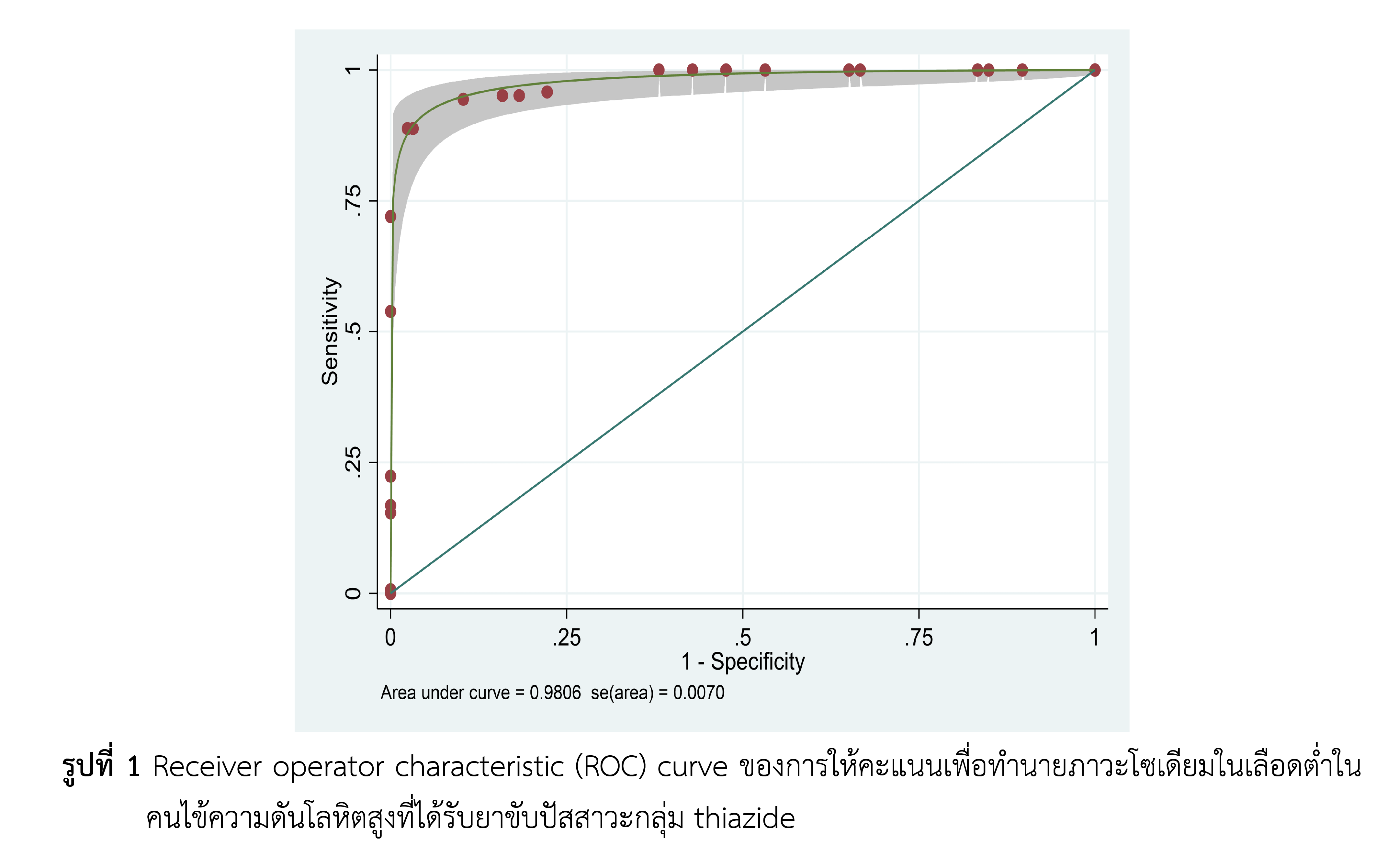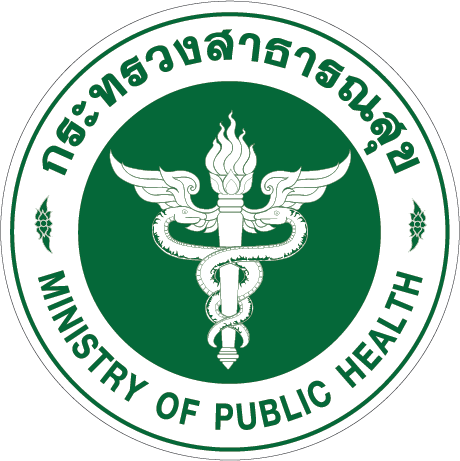Validation of a Hyponatremia Screening Tool (ABCDF-S score) for Patients with Hypertension Using Thiazide Diuretic Agents in Phrae Province
Keywords:
validation, hyponatremia, thiazide diureticsAbstract
Backgroud: High blood pressure is a common chronic disease with increasing tendency. In treatment, thiazide drugs are used as monotherapy or in combination with other drugs. The most common adverse reactions are hyponatremia, which can lead to illness and death. The hyponatremia screening tool (ABCDF-S score) requires validation to expand its general use.
Objectives: To study the associations and risk factors associated with hyponatremia in hypertensive patients using thiazide diuretics and to verify the validity of the hyponatremia screening tool.
Methods: A retrospective cohort study, descriptive statistics were used to test the hypothesis: Chi-square, odds ratio to calculate risk factor association, and receiver operator characteristic (ROC) curve to assess the overall efficiency of the instrument to predict hyponatremia. Data of hypertensive patients using thiazide diuretics were collected from a patient database from a hospital in a province. For the period from 1 October 2016 to 30 September 2019
Results: An analysis of risk factors associated with hyponatremia and screening scores based on the ABCDF-S score were evaluated in the high-risk group (score > 8) demonstrating sensitivity, specificity and accuracy: 88.81%, 84.13 and 86.62, respectively. In the low-risk group (score < 6) sensitivity, specificity and accuracy were shown to be 84.13%, 88.81% and 86.62, respectively, which were within the statistical criteria. Cut-off scoring to predict high- and low-risk groups confirmed according to AuROC data 98.06%
Conclusion: The ABCDF-S score tool can be used to predict hyponatremia with good accuracy when tested in all patients. Clinical pharmacists and physicians can easily assess the risk of hyponatremia. This tool should be considered at the beginning of prescribing thiazide diuretics for maximum benefit.
References
Bharati VM, Ajayi KS. Hypertension in the developing world: challenges and opportunities. Am J Kidney Dis. 2015;5:590-8.
Kayima J, Nankabirwa J, Sinabulya I, Nakibuuka J, Zhu X, Rahman M, et al. Determinants of hypertension in a young adult Ugandan population in epidemiological transition-the MEPI-CVD survey. BMC Pub Health. 2015;15:830-42.
สำนักนโยบายและยุทธศาสตร์ สำนักงานปลัดกระทรวงสาธารณสุข. แผนยุทธศาสตร์ชาติ ระยะ 20 ปี (ด้านสาธารณสุข) [อินเตอร์เน็ต]. นนทบุรี: กระทรวงสาธารณสุข; 2559 [เข้าถึงเมื่อ 13 สิงหาคม 2561]. เข้าถึงได้จาก: http://www.oic.go.th/FILEWEB/CABINFOCENTER2/DRAWER023/GENERAL/DATA0000/00000077.PDF
Sakboonyarat B, Rangsin R, Kantiwong A, Mungthin M. Prevalence and associated factors of uncontrolled hypertension among hypertensive patients: a nation-wide survey in Thailand. BMC Res Notes. 2019;12(1):380.
สมาคมความดันโลหิตสูงแห่งประเทศไทย. แนวทางการรักษาโรคความดันโลหิตสูงในเวชปฏิบัติทั่วไป พ.ศ. 2562. กรุงเทพฯ: ทริค ธิงค์; 2562. หน้า 1-23.
Gabb GM, Mangoni AA, Anderson CS, Cowley D, Dowden JS, Golledge J, et al. Guideline for the diagnosis and management of hypertension in adults - 2016. Med J. 2016;205:85–9.
Wright JM, Musini VM, Gill R. First-line drugs for hypertension. Cochrane Database Syst Rev. 2018 Apr. doi: 10.1002/14651858.CD001841.pub3
Hwang KS, Kim GH. Thiazide-induced hyponatremia. Electrolyte Blood Press. 2010;8(1):51-7. doi: 10.5049/EBP.2010.8.1.5
Sonnenblick M, Friedlander Y, Rosin AJ. Diuretic-induced severe hyponatremia. Review and analysis of 129 reported patients. Chest. 1993;103:601-6.
Glover M, Clayton J. Thiazide-induced hyponatraemia: epidemiology and clues to pathogenesis. Cardiovasc Ther. 2012;30:e219–26.
Kanchanasurakit S, Saokaew S, Siriplabpla W, Arsu A, Boonmak W, Watcharasiriphong W. Development of a hyponatremia screening tool (ABCDF-S score) for patients with hypertension using thiazide diuretic agents. J Clin Pharm Ther. 2020;00:1–9.

Downloads
Published
How to Cite
Issue
Section
License
Copyright (c) 2022 Health Administration Division, Office of the Permanent Secretary, Ministry of Public Health and The Society of Hospital Pharmacist, Ministry of Public Health

This work is licensed under a Creative Commons Attribution-NonCommercial-NoDerivatives 4.0 International License.
ข้อความภายในบทความที่ตีพิมพ์ในวารสารเภสัชกรรมคลินิกทั้งหมด รวมถึงรูปภาพประกอบ ตาราง เป็นลิขสิทธิ์ของกองบริหารการสาธารณสุข สำนักงานปลัดกระทรวงสาธารณสุข และ ชมรมเภสัชกรโรงพยาบาลกระทรวงสาธารณสุข การนำเนื้อหา ข้อความหรือข้อคิดเห็น รูปภาพ ตาราง ของบทความไปจัดพิมพ์เผยแพร่ในรูปแบบต่าง ๆ เพื่อใช้ประโยชน์ในเชิงพาณิชย์ ต้องได้รับอนุญาตจากกองบรรณาธิการวารสารเภสัชกรรมคลินิกอย่างเป็นลายลักษณ์อักษร
กองบริหารการสาธารณสุข สำนักงานปลัดกระทรวงสาธารณสุข และ ชมรมเภสัชกรโรงพยาบาลกระทรวงสาธารณสุข อนุญาตให้สามารถนำไฟล์บทความไปใช้ประโยชน์และเผยแพร่ต่อได้ โดยอยู่ภายใต้เงื่อนไขสัญญาอนุญาตครีเอทีฟคอมมอน (Creative Commons License: CC) โดย ต้องแสดงที่มาจากวารสาร – ไม่ใช้เพื่อการค้า – ห้ามแก้ไขดัดแปลง, Attribution-NonCommercial-NoDerivatives 4.0 International (CC BY-NC-ND 4.0)
ข้อความที่ปรากฏในบทความในวารสารเป็นความคิดเห็นส่วนตัวของผู้เขียนแต่ละท่านไม่เกี่ยวข้องกับกองบริหารการสาธารณสุข สำนักงานปลัดกระทรวงสาธารณสุข และ ชมรมเภสัชกรโรงพยาบาลกระทรวงสาธารณสุข และบุคลากรในกองฯ หรือ ชมรมฯ แต่อย่างใด ความรับผิดชอบองค์ประกอบทั้งหมดของบทความแต่ละเรื่องเป็นของผู้เขียนแต่ละท่าน หากมีความผิดพลาดใด ๆ ผู้เขียนแต่ละท่านจะรับผิดชอบบทความของตนเอง ตลอดจนความรับผิดชอบด้านเนื้อหาและการตรวจร่างบทความเป็นของผู้เขียน ไม่เกี่ยวข้องกับกองบรรณาธิการ



